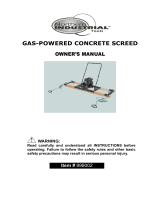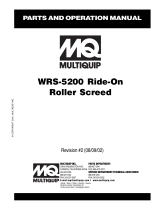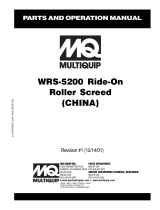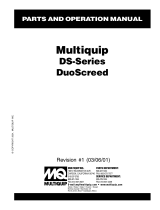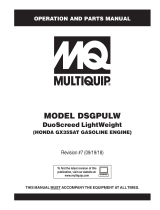

1
Table of Contents
i…………………………………………………………………………………………………………………………………………………….COVER
1………………………………………………………………………………………………………………………………TABLE OF CONTENTS
2…….……………………………………………………………………………………………………………………………….……SAFETY FIRST
3…………………………………………………………………………………………………………………………START UP INSTRUCTIONS
4-6….…………………………………………………………………………………………………………………………………………ASSEMBLY
7………………………………………………………………………………………………………………………………………OPERATING TIPS
8….……………………………………………………………………………………………………………..…………TOLERANCE & MATRIX
9……………………………………………………………………………………………………………………………….FRICTION METHOD
10………………………………………………………………………………………………………..…….FORMWORK AND COLD SLABS
11…………………………………………………………………………………………………………………………DRIVE BODY ASSEMBLY
12………………………………………………………………………………………………………………………...DRIVE BODY PARTS LIST
13…………………………………………………………………………….………………WC50 GEAR BOX ASSEMBLY & PARTS LIST
14………………………………………………………………………………………WC50 KICK STAND ASSEMBLY AND PARTS LIST
15…..………………………………………….……………..DPH200 DRIVE END PULL HANDLE ASSEMBLY AND PARTS LIST
16……………………………………………………….OPH100 OPPOSITE END PULL HANDLE ASSEMBLY AND PARTS LIST
17…………………………………………………... ORS100 OPPOSITE END ROLLER SWIVEL ASSEMBLY AND PARTS LIST
18……………………………….MV410 KICKSTAND AND PR610 CROSS BAR CLAMP ASSEMBLIES AND PARTS LISTS
19….……………………DPSA6 & DPSA45 - 6” & 4.5’’ DRIVE END SELF ALIGN PLUG ASSEMBLY AND PARTS LIST
20………………….OPSA6 & OPSA45- 6’’ & 4.5’’ OPPOSITE END SELF ALIGN PLUG ASSEMBLY AND PARTS LIST

2
Concreting is hard work but with the correct use of your Roller Screed, “It’s never been
easier.”
a. Remember your Roller Screed is a mechanical machine having considerable
torque. Don’t attempt to mess with “Superman” - You’re in a no win situation.
b. Never operate the equipment or stand near the machine/tube with loose items of
clothing about your person (eg. Draw cords on wet weather clothing). These could
become entangled around the tube which may mean you could be drawn in and
cause bodily injury.
c. As the Screeding machine is being pulled backwards during strike-off, the
operator should take extreme caution not to slip and become entangled on a mesh
pour. Should this occur, a sprung throttle device is provided to ensure the machine
stops immediately, should the operator’s hand leave the trigger.

3
Serial Number: _____________________
Engine Number: _____________________
Requirement
For Safety in Shipping, both fuel and oil have been removed and they must be replaced
prior to start-up.
a. Unleaded Gasoline (Petrol) ONLY.
b. 2.7 oz. of 4-Stroke Premium Engine Oil (10w/30 Grade) Change oil every 50 hrs
Uncrate
The following are components supplied with your machine:
1- Roller Screed Drive End Assembly
1- Opposite End Handle Assembly
1- Drive End Self-Align Plug with Spring Pin
1- Opposite End Self-Align Plug with Spring Pin
1- Operation Instruction Manual
Optional
Weight kit
Roller Screed Tube
Transportation & Storage
Remove the spring pins from opposite and drive end plugs to remove tube from machine
and handle. Stabilize the unit while in transit to protect the tube and engine. Store in a
dry, safe environment when the machine is not in use.
Maintenance
No scheduled maintenance on gears or Roller Screed parts. Clean any concrete from unit
and tube after every use. Allowing concrete to dry on unit or tube may cause harm to
unit.
ATTENTION!
FOR PROPER CARE, SAFETY INSTRUCTIONS, MAINTENANCE AND HONDA
ENGINE OPERATION INSTRUCTIONS READ AND FULLY UNDERSTAND THE
HONDA ENGINE OWNERS MANUAL.

4
Assembly
Alignment plugs
Insert Self-Align Plugs into Roller Tube as seen below. Fig. 5A
Tighten the three bolts on the Self-Align Plugs until the plug is secured in the tube. Leave
no gap between the plug and tube. (DO NOT over tighten.) Fig. 5B
Figure 5A Figure 5B
Attaching drive end
Remove the spring pin from drive end. Attach the Roller Screed Drive End Assembly to
the Drive End Align Plug, securing it with the spring pin. See Fig. 5C
Figure 5C

5
Assembly
Attaching opposite end handle
Remove Spring Pin from the
opposite end plug. Attach
Opposite End Handle
Assembly to the Opposite
End Plug (opposite of the
power unit), securing it with
the spring pin. See Fig 6A
Figure 6A
Setting up handles & kickstand
To make transportation &
storage easier, the drive handle is
locked in the upright position. To
unlock, remove the hitch pin
from handle stop shown in
Fig. 6B
Figure 6B

6
Assembly
Pull the drive handle back
until the other hole is lined
up. Put the hitch pin back in
to lock handle shown in Fig
7A. Loosen kickstand knob
and pull out kickstand to
allow handle to stand up
Figure7A
Ready to use
Start up the engine and let it warm up (3 – 5 min) before operating at normal throttle.
(See the Honda Manual for detailed instruction on how to start engine.)
Lift the entire unit and place
upon the forms within the pour
itself. Once placement has
begun, ensure that the concrete
covers the entire bay between
the forms before attempting
the screeding process.
Deflection is a consideration in
any type of screeding machine
marketed and it is imperative
that the concrete itself supports
a portion of the weight of the
tube when in operation, this
makes for flatter floor

7
Operating Tips
No initial training is required to operate the equipment, but a good understanding of how
concrete works is recommended.
Do not use equipment in extreme weather conditions (rain, sleet, snow, etc.). Moisture
inside the engine can cause damage.
When you pick a tube for a slab, exceed the span by at least 600mm (2 ft.). If you are
going to be working around a lot of obstructions, give yourself at least 900mm (3 ft.) As
you approach an obstruction, one operator will lag as the other advances to cut a steep
angle. Then they switch to an opposite angle and jump. At this point, manually trim the
“V” shaped area forward just enough for the tube to grab it, and then proceed.
Metal expands and contracts according to its temperature. This causes the tube to bow
when it has been parked for a period of 30 seconds in direct sunlight. The differences in
temperature between the sunny side and the concrete side makes the tube deflect slightly.
You may not notice this in a span less than 7.9m (26ft.). You can strike in heavier build
up for 30 seconds or more to bring your tube to a proper temperature. This should be
done before you attempt to venture back onto a previous area to begin a strike-off pass.
Special care must be taken with tubes 7.9m (26ft.) or longer. Novice operators will find
themselves unsure of whether to proceed or to back up. If you stop traveling with the
tube spinning, you will notice it begin to jump slightly. Tubes of this length will tend to
flex under this condition, if they aren’t traveling either forward or back. Always spin
long length tubes slightly slower than you would tubes of less than 7m (23ft).
If you are going to stop, turn off the tube. Also, tubes of 7.9m (26ft) or longer run at a
slower rpm than shorter tubes. With care, one can expect good strikes to a span of 8.5m
(28ft). Even though we sell tubes longer than 8.5m (28ft), they are not expected to span
any wider than 8.5m (28ft). Avoid excessive passes when using tubes over 7.9m (26ft).
Make one pass to strike off the excess, then another pass to correct any errors and provide
a uniform surface.
In pursuit of a low slump and superflat slabs, you will find your tube very useful in
floating and trimming procedures. You may use the tube to trim the surface after the slab
is partially set. If you are adding material or color to the surface, the tube will introduce
these materials into the surface, by traveling with the spin. You still lift the valve to the
up position, but always travel back instead of striking forward.

8
Tolerance
An ideal concrete mix design has a slump of 100mm (4 inches). Slump any wetter is a
step in the wrong direction. This tool operates on friction between the face of the tube
and the major aggregate. When working properly, the buildup breaks away from the
body of the slab to tumble ahead of the tube. If the slump is too wet, the tube cannot
gather or accumulate this build up properly. Under this condition, you will see the
buildup slide ahead of the tube, rather than tumble.
When the tool is on a level slab, it is pulled by the operators at an upward angle. If you
operate light tubes in a slump which is 76mm (3 inches) or lower, they will tend to ride
high when they encounter build up. This is more pronounced if the major aggregate is
larger than 37mm (1’). This is not the case on slope because the tool is drawn forward in
the line with the plane of the slab.
Matrix
Finishers who are accustomed to the surface left by a vibratory screed, are usually
startled by the presence of major aggregate existing at the surface. Don’t panic. You
must realize that when the slab is this flat, you do not need a lot of fine material on top, to
apply a finish. As you reach about mid set, you will feel the stability of this major
aggregate holding your surface from shifting during floating process.
Jobs with quality control supervision will not allow surface vibration because of the
segregation of materials at the surface. The heaviest item in the mix is rock and the
lightest is water. Surface vibration causes the surface to result in lower density. It also
causes an increased water/cement ratio in this critical area of the slab. The Rollerscreed
tube is widely accepted, specifically because of its ability to consolidate without
segregation.
The presence of major aggregate at the surface provides the ultimate performance,
because of the increased density. This requires some care in the form of maintaining a
more shallow pitch in your troweling habits. The ready mix producer has more to do
with this than anything. If your aggregate is crushed with sharp fractures or if it is
uncommonly bony, you may need to take measures to crowd the large rock away from
the surface slightly.
There is a lot of chemistry used in making ready mix products to meet the required
strength, while cement content is reduced. You must get a feel for your concrete, to tune
in on a method that works for you. Concrete supplies will vary, from one to another, as
so their products.

9
Friction Method
The friction screed has become an alternative to the surface vibrator.
This tool is a spinning tube, manually drawn over the slab. The face of the spinning tube
encounters the surface, sweeping the excess concrete forward. This method aggressively
cuts the high material into a roll which gathers in front of the tube. This allows operators
to grasp the high material and remove it from the surface. This step is so effective,
operators use the tube for preliminary placement, as well as striking the final grade.
Step 1: Placement. Delivery begins as workmen have filled the first corner and across
the starting edge. Grade is a little high, to assure the area is full. Delivery continues, but
the starting area is not completely full on the other side. The workmen are unsure of the
exact grade, so they make a quick strike with the tube. This removes the over burden,
which is brought forward, then the spinning tube races back out of the way.
The delivery continues with your men and the mixer operator knowing exactly how far
your placement currently stands. The delivery happens at a much quicker pace because
they can see the placement volume by watching the tube. As high and low spots appear,
they are visible and obvious. The rotation of the tube carries itself back to recover any of
these flaws that appear.
Step 2: Strike-Off. Once an area has received the proper volume of delivery and the over
burden has been removed, the final strike is made. This provides a flat grade, consistent
with the formwork, ready for the finish tools.
Timing is most critical. Within two minutes after the material is dropped, you have the
initial strike. After that, the body of the slab is in place. The material which moves after
that point is a matter of texture.
The Rollerscreed tube gives powerful control of surface grade, during this precious
window of time. Don’t wait even a few minutes for workmen to walk around in your
delivery area, raking this material to grade. Keep a man there push some fill back into
the holes which occur. Get the rest of the men out of the way and cut the grade with the
tube.
You can maintain a better flatness if you cut grade immediately upon placement.
Using friction to cut grade is very precise and it is also quick. The Rollerscreed tube is
not capable of the tremendous width, as that of the vibratory screed. In big areas the tube
must be used in multiple rows, using temporary Pinheads. However, the speed, in square
feet per hour, is comparative with the speed of wider vibratory screeds.
The aggregate is left undisturbed, at the surface. A thin layer of fines is present, adequate
for a smooth finish. The matrix of aggregate is still intact, giving high density and
providing stability for finishing machines.
As the Rollerscreed tube bites the surface, the force is directed against the high material.
That which exists at proper grade is left undisturbed, except for the shear, applied by the
Bottom and face of the tube. As a result, the arrangement of the aggregate is left intact,
in its proper matrix.

10
Formwork and Cold Slabs
Your setup probably includes some of the following:
Cold slabs
Formwork
Temporary
The strike-off is done supported by the setup. Since your setup gives reference for grade,
The final surface tolerance can be only as pure as the setup.
The Rollerscreed tube cuts grade slightly lower than the setup. This is similar to the
conditions which occur when using manual strike-off. Then, shrinking occurs in the
concrete, during hydration. The final surface will arrive at 3mm (1/8”) below the
formwork. Formwork should be set artificially high, by 3mm (1/8”). Finishers should be
advised to avoid filling the edges to form level, since the desired grade is slightly lower.
Similarly, cold slabs are spaced. With a 3mm (1/8”) strip of flat steel, so the final grade
will match the cold slab. The strip of flat steel prevents excessive wear to the tube. This
wear becomes significant, when the tube extends over a cold slab which has a rough
texture.

20 13
22 37 3936 38
14
35 16 40
47
21
23
19
11
2 7 1 5 4424176
30
3132 4634 2728
29
48
41
33
45
4
43
42
9
8
3
22
10
25
18
26
12 15
DB500 - DRIVE BODY ASSEMBLY
11

DB500 - DRIVE BODY PARTS LIST
12
ITEM NO.
PART NO.
DESCRIPTION
QTY.
1
D116
1 1/4 X 6" SS OUTPUT SHAFT
1
2
D127
1 1/4" NO40 CHAIN SPROCKET
1
3
DB100
ENGINE SIDE PLATE 1
4
DB120
TUBE SIDE PLATE
1
5
D119
3-1/2" BEARING CARRIER
2
6
D120
1 1/4" OD ROLLER BEARING
2
7
D121
1/4" X 1/2" KEY STOCK
1
8
PR564
3/8-16 X 1" SCHS
4
9
MV83
3/8-16 X 1" HHCS
4
10
D110
GEAR BOX SUPPORT PLATE
1
11
DB270
3/4"ID - 1 4/5" OD ROLLER BEARING
2
12
DB230
BEARING CARRIER
1
13
DB220
BEARING COVER PLATE
1
14
DB250
3/4 BORE #40 CHAIN SPROCKET
1
15
P141
RETAINING RING
2
16
DB160
TOP PLATE
1
17
D115
#40 CHAIN 42" LONG
1
18
DB190
SWIVEL MOUNT PLATE
1
19
D123
SUPPORT PLATE 1" X 4"
1
20
D103
3/8-16 X 1 1/2" HHCS
4
21
MV103
3/8-16 X 3" SHCS
2
22
D100
10-24 X 1/2" SCHS
30
23
D104
5/16-18 X 1" HHCS
12
24
DB140
COVER PLATE
1
25
DB150 INSPECT PLATE
2
26
DB180E
SWIVEL BASE - ELECTRIC
1
27
MV420
5/16-18 X 3/4" SHCS
4
28
SC158E
MALE HANDLE STOP
1
29
SC159E
FEMALE HANDLE STOP
1
30
MV198
5/16-18 X 3 1/2" HHCS
1
31
MV412
5/16 LOCK WASHER
1
32
MV411
5/16-18 LOCKING NUT
2
33
PR211
5/16-18 X 1 3/4" HHCS
1
34
P170
1/2-13 LOCKING HEX NUT
1
35
MV540
TUBING CAP
2
36
DB200
LIFT HANDLE TUBE
1
37
MV314
7/8 CAP PLUG
1
38
MV414
5/16-18 X 2 1/2" HHCS
1
39
D102
3/8-16 X 2 1/2" HHCS
1
40
MV304
LIFT HANDLE GRIP
1
41
MV143
3/8 X 2 1/4" HITCH PIN
1
42
D125-1
2 X 4 1/2" SS OUTPUT DRIVE ADPT
1
43
D124
3/8-16 X 5/8" SCHS
2
44
D118
DRIVE SHAFT COVER CAP
1
45
D106
NYLON CASING CLAMP
2
46
MV415
1/4" FLAT WASHER
1
47
P142
3/16" KEY STOCK
1
48
P160
1/2-16 X 3" HALF-THREAD HHCS
1

16
12
9
10
8
7
5
3
6
13
11
14
15
2
1
GBWC50 - WC50 GEARBOX
& PARTS LIST
13
ITEM NO.
PART NO.
DESCRIPTION
QTY.
1
GB1001
INPUT BOX SIDE
1
2
GB1002
OUTPUT BOX SIDE
1
3
GB1000
BALL BEARING R12 1 5/8 " OD X 3/4" ID
2
4
P177
1 5/8" GROOED DIA INT RING
2
5
GB1010
BALL BEARING R10 W 3/8 " BORE SIZE
1
6
GB1011
BALL BEARING R10 W 5/8" BORE SIZE
1
7
GB1031
CLUTCH DRUM 3" ROUND
1
8
GB1020
GEAR 7T PINION THREAD
1
9
GB1024
GEAR 12T PIION LH THREAD
1
10
GB1025
GEAR 48T LH THREAD
1
11
GB1023
GEAR 44T 3/4" HOLE
1
12
P141
RETAINING RING
2
13
MV102
3/8-16 X 5" SHCS
4
14
D114
DRIVE SHAFT
1
15
MV197
3/8 -16 X 2 3/4" SHCS
2
16
MV127
1/4 X 1/5 STEEL DOWEL PIN
1

6
14
13
12
11
9
7
4
3
5
2
21
10
D137 - CLUTCH SPACER
D138 - CLUTCH WASHER
RS50 - WC50 CLUTCH
MV720 & WC50 ENGINE- KICKSTAND
ASSEMBLY & PARTS LIST
14
WC80 -ITEMS NOT FURNISHED
BY HONDA
MV99 - SPRING
D136 - THROTTLE GUIDE
D100 - 10-24 X 1/2"
D134 - WC50 SPRING ARM
MV130 - 1/4 - 28 X 1/2" BHSCS
KEYSTOCK
MV415 - 1 1/4 FLAT WASHER
ITEM NO.
PART NO.
Description
QTY.
1
MV500
GX50 HONDA ENGINE
1
2
WC80
PARTS NOT FURNISHED BY HONDA
3
GB1050
ENGINE MOUTING PLATE
1
4
GB1041
ENGINE PLATE TO GEARBOX ADAPTER
1
5
MV199
.25-28 X 1.5IN SCHS
4
6
MV723
WC50 ENGINE KICK STAND PLATE
1
7
MV704
ENGINE STAND CLAMP
1
8
MV722
WC50 KICK STAND
1
9
MV721
KICK STAND CLAMP
1
10
MV179
3/8 FLAT WASHER
1
11
PR206
5/16-16 X PLASTIC KNOB
1
12
MV414
5/16-18 X 2.5IN HHCS
1
13
MV314
7/8" CAP PLUG
2
14
FC20
1.0 X 20 M6 SHCS
4

2
4
1
6
7
3
5
DPH200 - DRIVE END PULL HANDLE
ASSEMBLY & PART LIST
15
ITEM NO.
PART NUMBER
DESCRIPTION
QTY.
1
DPH100
TUBING - 37 1/2 X 1
1
2
PR610
CROSS BAR CLAMP
1
3
PH100
TUBING - 18X1
1
4
MV410
KICKSTAND CONNECTOR
1
5
PR601
HANDLE GRIP
2
6
MV400
KICKSTAND ASSEMBLY
1
7
DPH150
THROTTLE ASSEMBLY
1

4
3
5
19
2
8
7
6
OPH100 - OPPOSITE END PULL HANDLE
ASSEMBLY & PART LIST
16
ITEM NO.
PART NO.
Description
QTY.
1
OPH125
OPPOSITE END HANDLE BRACKET
1
2
OPH120
TUBING 43 X 1
1
3
PR610
CROSS BAR CLAMP
1
4
PH100
TUBING - 18X1
1
5
OPH126
.25" X 1" SPRING PIN
2
6
MV410
KICKSTAND CONNECTOR
1
7
PR601
HANDLE GRIP
2
8
MV400
KICKSTAND ASSEMBLY
1
9
ORS100
OPPOSITE END ROLLER SWIVEL 1

4
3
2
1
8
5
7
6
9
ITEM NO.
PART NO.
DESCRIPTION
QTY.
1
SC100
SWIVEL CASE
1
2
SC120 BEARING SHAFT
1
3
DB270
.75 X 1.8 ROLLER BEARING
2
4
SC130
BEARING SPACER
1
5
SC110
END CAP
1
6
P141
RETAINING RING
1
7
D100
10-24 X .50 SCHS
4
8
P160
.5-16 X 3 X 1.5THREAD HHCS
1
9
P170
.5-13 LOCKING HEX NUT
1
ORS100 - OPPOSITE END ROLLER
SWIVEL ASSEMBLY & PART LIST
17

1
6
5
2
3
4
4
3
1
2
18
MV410 - KICKSTAND CONNECTOR ASSEMBLY
& PARTS LIST
PR610 - CROSS BAR CLAMP ASSEMBLY
& PARTS LIST
ITEM NO.
PART NO.
DESCRIPTION
QTY.
1
PR613
T -CAMLP
1
2
PR616
1/4-20 X 1 3/4 CH BOLT
2
3
PR612 1/4 LOCK WASHER
2
4
PR611
1/4 NYLON LOCK NUT
2
ITEM NO.
PART NO.
DESCRIPTION
QTY.
1
MV413
U -CLAMP
1
2
MV415
1/4 FLAT WASHER
5
3
MV416
5/16 X 2 1/2 PLASTIC KNOB
1
4
MV414
5/16 - 18 X 2 1/2 HHCS
2
5
MV411
5/16 - 18 NYLON LOCK NUT
1
6
MV412
5/16 LOCK WASHER
2

2
3
1
8
5
7
6
4
2
1
3
4
7
6
5
8
DPSA6 - 6''DRIVE END SELF ALIGN
PLUG & PARTS LIST
DPSA45 - 4.5'' DRIVE END SELF ALIGN
PLUG & PARTS LIST
ITEM NO.
PART NO.
DESCRIPTION
QTY.
1
DPS45
DRIVE PLUG SELF ALIGN SHAFT 4.5"
1
2
P121
PLUG BACK PLATE
1
3
MV139
1/4" X 1-1/2" SPRING PIN
1
4
P130
URETHANE PLUG - 4"
4
5
P111
PLUG FACE PLATE
1
6
MV105
5/16-18 X 9" HHCS
3
7
MV415
1/4" FLAT WASHER
3
8
P147
3/8 X 2-1/4 SW DW SNAP PIN
1
ITEM NO.
PART NO.
DESCRIPTION
QTY.
1
DPS6
DRIVE PLUG SELF ALIGN SHAFT - 6"
1
2
P121-1
PLUG BACK PLATE 6"
1
3
MV139
1/4" X 1-1/2" SPRING PIN
1
4
P131
URETHANE PLUG - 6"
3
5
P111-1
PLUG FACE PLATE 6"
1
6
MV110
3/8-16 X 12" HHCS
3
7
P147
3/8 X 2-1/4 SW DW SNAP PIN
1
8
MV417
5/16 FLAT WASHER
3
19
Page is loading ...
/
